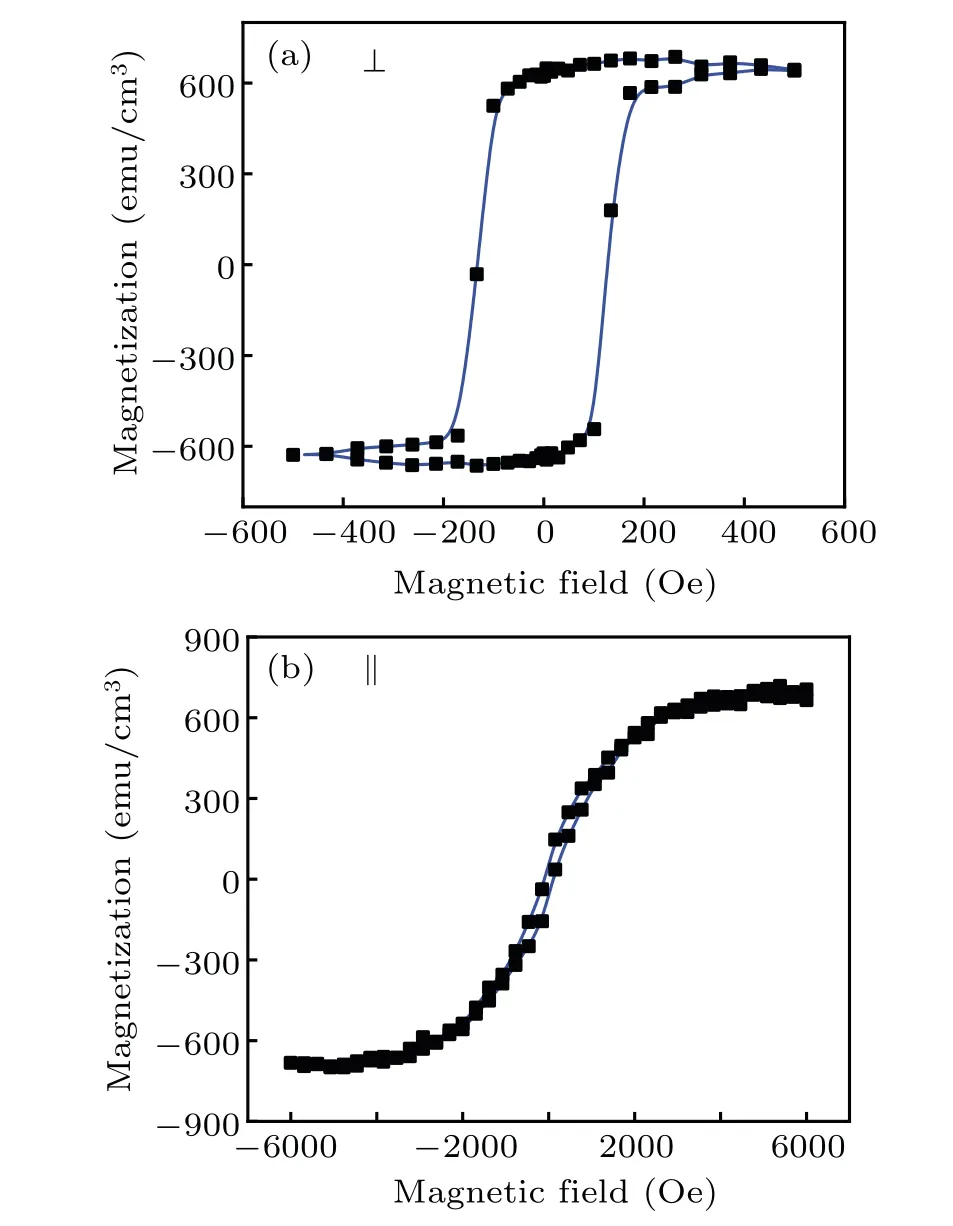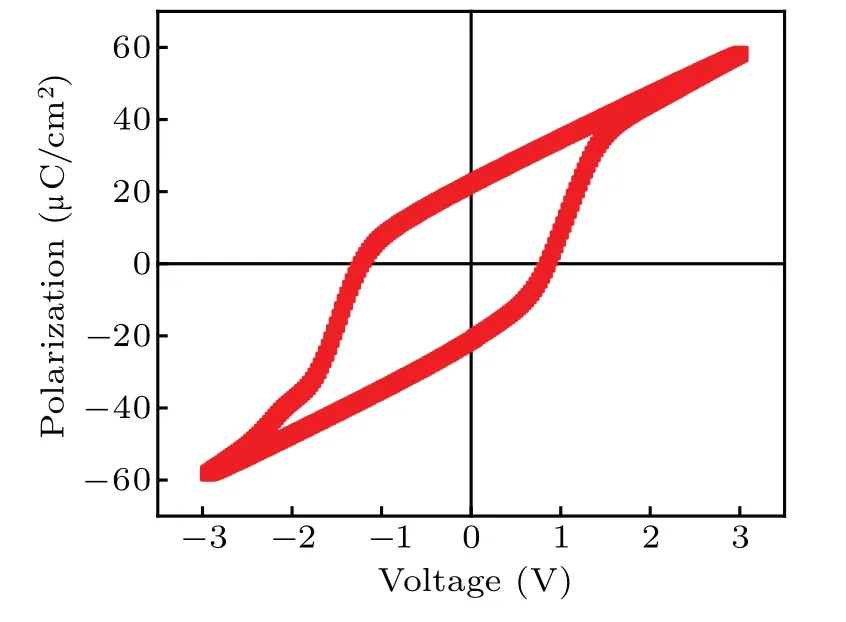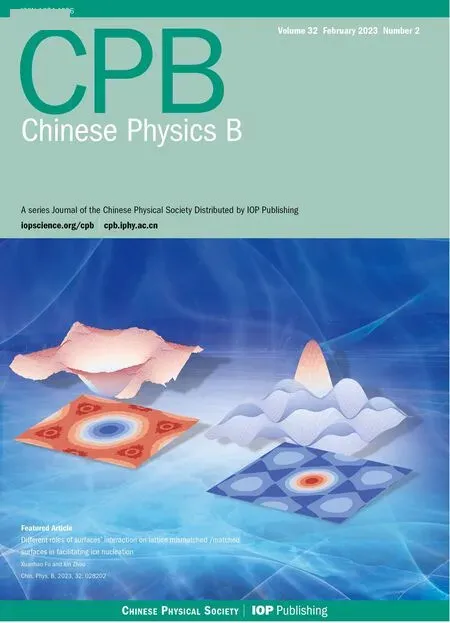Charge-mediated voltage modulation of magnetism in Hf0.5Zr0.5O2/Co multiferroic heterojunction
2023-03-13JiaChen陈佳PeiyueYu于沛玥LeiZhao赵磊YanruLi李彦如MeiyinYang杨美音JingXu许静JianfengGao高建峰WeibingLiu刘卫兵JunfengLi李俊峰WenwuWang王文武JinKang康劲WeihaiBu卜伟海KaiZheng郑凯BingjunYang杨秉君LeiYue岳磊ChaoZuo左超YanCui崔岩andJunLuo罗军
Jia Chen(陈佳) Peiyue Yu(于沛玥) Lei Zhao(赵磊) Yanru Li(李彦如) Meiyin Yang(杨美音)Jing Xu(许静) Jianfeng Gao(高建峰) Weibing Liu(刘卫兵) Junfeng Li(李俊峰)Wenwu Wang(王文武) Jin Kang(康劲) Weihai Bu(卜伟海) Kai Zheng(郑凯)Bingjun Yang(杨秉君) Lei Yue(岳磊) Chao Zuo(左超) Yan Cui(崔岩) and Jun Luo(罗军)
1Institute of Microelectronics,Chinese Academy of Sciences,Beijing 100029,China
2University of Chinese of Academy Sciences(UCAS),Beijing 100049,China
3Semiconductor Technology Innovation Center(Beijing)Corporation,Beijing 100176,China
4ULVAC Research Center Suzhou CO.,Ltd.,Suzhou 215026,China
Keywords: multiferroic heterojunction,voltage-controlled magnetism,energy barrier
1.Introduction
Nowadays, 22-nm/28-nm embedded magneto-resistive random-access memory (eMRAM) is already used in industrial production.For the continuous scaling down, the better performance such as low power consumption and high thermal stability are desired.The energy barrier which separates two stable magnetizations is a crucial factor that decides the power consumption of data writing and thermal stability for MRAM.During the data writing, a lower energy barrier favors lower power consumption.On the other hand, a higher energy barrier means better stability against thermal disturbance, which is beneficial to data retention.
Voltage-controlled magnetism is an effective method that can modulate magnetic behaviors such as coercivity,magnetization,magnetization switching,etc.[1-4]And it is also a useful way to control the energy barrier of magnetic material.The common forms of the voltage-controlled magnetism include voltage-controlled magnetic anisotropy (VCMA), magnetoionic effect, and multiferroic structure,etc.VCMA is commonly adopted in ferromagnetic/dielectric material system,the accumulation or dissipation of electrons at the interface under different voltages can control magnetic anisotropy and change energy barrier.[5-7]While VCMA effect is volatile, it is hard to modulate thermal stability for a long time.Magnetoionic effect is a method based on ion migration driven by electric field.Though magneto-ionic effect can impact magnetic property remarkably, it often needs long time, higher voltage or thermal assistance, which is not suitable for MRAM.[8-11]Ferroelectric/ferromagnetic composition is one of most studied multiferroic structures.Similarly,accumulation or dissipation of electrons at the interface can be realized due to ferroelectric polarization under different voltages.Unlike VCMA,the state of interfacial electrons can keep stable after the disappearance of voltage, which can achieve the target of lower energy barrier in data writing and higher energy barrier in data retention simultaneously.[12,13]
In this work, a multiferroic heterojunction comprised of HfO2-based ferroelectric and Co ferromagnetic film is formed.Because of the reasonable design of film stacks and process,the heterojunction possesses both ferroelectricity and perpendicular magnetic anisotropy (PMA).The controllable magnetic behaviors including nucleation field, coercivity by different voltage pulses are found in Hall-bar device with the size of several hundred nanometers.Besides,through the calculation of effective anisotropy energy density under different voltage pulses,an efficient modulation on energy barrier is observed.What is more,all the above voltage-controlled properties are reversible and non-volatile.Considering the ferroelectricity, we attribute the voltage-controlled magnetism of the heterojunction to charge-dependent mechanism at the interface between ferroelectric and ferromagnetic layer.The study of voltage-controlled magnetic behaviors reveals the promising potential application of ferroelectric/ferromagnetic heterojunction in low-power and high-stability MRAM.
2.Experiment details
As shown in Fig.1, the film stacks in this work are Si/TiN(10 nm)/Hf0.5Zr0.5O2(10 nm)/Pt(0.5 nm)/Co(1 nm)/Ru(4 nm).The bottom electrode TiN is grown on 8-inch (1 inch=2.54 cm) Si substrate by magnetron sputtering, then the Hf0.5Zr0.5O2(HZO) layer is deposited through atomic layer deposition(ALD)using deionized water,Hf(NCH3C2H5)4and Zr(NCH3CH5)4as precursor,and the Pt,Co,Ru are grown by magnetron sputtering in sequence.After the film deposition, a 30-s annealing of temperature 400°C under N2is performed by rapid thermal annealing(RTA)system.Then, a 50-nm Si3N4is covered on the films as hard mask through plasma enhanced chemical vapor deposition(PECVD).Finally,the film stacks are processed by deep ultraviolet lithography (DUV), inductively coupled plasma (ICP)etching,passivation,interconnection and fabricated into Hallbar device with the size of several hundred nanometers covered by passivation layer of Si3N4.
The basic magnetic property of films is performed on vibrating sample magnetometer(VSM),and the other measurement including anomalous Hall effect (AHE) test, voltagecontrolled magnetism and ferroelectric property are performed on the Hall-bar device fabricated by 8-inch process.

Fig.1.(a)The film stacks and(b)the main processes of the film deposition.
3.Results and discussion
After the etching of hard mask, the whole morphology of Hall-bar structure is shown in Fig.2(a) obtained by scanning electron microscope (SEM).As presented in Fig.2(b),the width of channel is about 593 nm, the total area of the Hall-bar structure is about 100µm2.In order to get more details and prove the process,transmission electron microscopy(TEM)and related analysis are performed on the finished Hallbar device.Figure 2(c)presents the cross-sectional TEM image of the film stacks, all the layers can be seen clearly and the HZO layer shows polycrystalline morphology which is a typical feature of HfO2-based ferroelectric material.[14,15]Figure 2(d) exhibits the sidewall of Hall-bar structure from which we determine that the etching endpoint is in the HZO layer, which meets our expectation.The energy dispersive x-ray spectroscopy (EDX) is used to analyze distribution of elements, the slight indentations of Zr and Hf demonstrate the etching endpoint again.Obvious element diffusion is not found in the mapping results.Besides,we discover the appearance of some elements such as Hf, Zr, Pt, Ru at the sidewall which is caused by redeposition during etching.[16-19]

Fig.2.(a)The top view of Hall-bar device obtained by SEM.(b)The channel SEM image of Hall-bar device.(c)The cross-sectional TEM image of film stacks.(d)The sidewall TEM image of Hall-bar device.(e)The distribution map of elements around sidewall.
The magnetic hysteresis loops of film stacks after RTA implemented by VSM are shown in Fig.3.The magnetization reaches saturation at a smaller magnetic field and presents nearly 100% remanent magnetization under perpendicular magnetic field, while a larger saturation field and almost zero remanent magnetization are exhibited in theM-Hcurve measured under parallel magnetic field.The results indicate the film possesses PMA which mainly originates from the interfacial anisotropy.[20-22]From the measurement, we can get the saturation magnetization with the amplitude of 650 emu/cm3.

Fig.3.The magnetic hysteresis loops of the film under perpendicular magnetic field (a) and parallel magnetic field (b).The unit 1 Oe=79.5775 A·m-1.
For the Hall-bar device fabricated by 8-inch process,AHE test is used to detect the kinetic magnetism.During the measurement,the Hall resistance alongyaxis is measured by Keithley 2450 while a 50-µA current generated by Keithley 2602B is applied on thexaxis under perpendicular magnetic field as shown in Fig.4(a).The AHE is an electrical transport measurement method which can be expressed as[23-25]
the anomalous Hall resistanceRHis comprised by ordinary part(R0B/t)and anomalous part(4πRsM/t),in whichtis the thickness of current channel andBis external magnetic field.Usually,the anomalous Hall coefficientRsis much larger than ordinary Hall coefficientR0, as a result, theRHis directly proportional to the perpendicular component of magnetization(M) which is used to study magnetic property.Like the test of VSM,the result in Fig.4(b)also presents rectangular loop which indicates the PMA keeps stable as the scaling down of the film stacks,proving the reliability of process.

Fig.4.(a)The diagram of AHE test.(b)The R-H curve of Hall-bar device under perpendicular field.
In order to investigate the effect on magnetic property caused by voltage,the AHE measurement with different voltage pulses are carried out.As shown in Fig.5(a), the 9-ms voltage pulse supplied by Keithley 2602B is applied on the HZO layer through the top and bottom electrode,after cutting off the voltage pulse,an AHE measurement is performed.Before and after the voltage pulse, the resistance of HZO layer is measured to ensure its intact.The electric field that points from top to bottom electrode is defined as positive andvice versa.An obvious deformation of the AHE curve is observed under different voltage pulses.After a-3-V pulse,the curve around coercivity becomes more sloping,which has a smaller nucleation field (Hn~15 Oe) and coercivity (Hc~160 Oe),while the saturation field is almost unchanged(Hs~254 Oe).On the contrary,when a 3-V pulse is applied on the device,the curve becomes more sharper, which has a larger nucleation field (Hn~172 Oe) and coercivity (Hc~225 Oe), the saturation field still keeps stable.Besides, a slight decrease and increase in saturation Hall resistance under negative and positive voltage pulse also emerges.Figure 5(c)presents involved fields under different voltage pulses, the different slopes of three curves indicate the different responses to voltage pulsethe sensitiveHN, slightly changedHcand stableHs.The various discrete extent of the three fields shows the different switching processes under different voltage pulses.
The energy barrierEbof magnetic layer can be expressed as the product of effective anisotropy energy densityKuand volumeV.[26,27]We can getKuby the difference in magnetization work between the direction of hard-axis and easy-axis written as follows(for PMA):[28,29]

in whichMxandMzare in-plane and perpendicular components of magnetization,RNoris the normalized Hall resistance.Figure 5(d) is the in-plane normalizedR-Hcurves under different voltage pulses.Through the above method,theKuunder different voltage pulses is obtained and shown in Fig.5(e).From the results, the voltage pulse has remarkable influence on theKu.TheKuis about 5.2×104erg/cm3(1 erg=10-7J)after a-3-V pulse,which is reduced by 83%compared with initial value (3.2×105erg/cm3), and it is enhanced to 4.1×105erg/cm3after a 3-V pulse, which is increased by 28%.The controlled coefficient calculated from fitting result is about 5.89×10-2erg/(V·cm2).The voltagedependentKuimplies bidirectional change in energy barrier based on the polarity of voltage.As depicted above, there is no voltage on the HZO layer during AHE test, therefore, the effect on magnetic property and energy barrier is non-volatile.In general, a reversible, non-volatile modulation on magnetic property, and energy barrier by voltage pulse can be realized in the HZO/Co heterojunction.

Fig.5.(a)The test diagram of voltage-controlled magnetism.(b)The R-H curves under perpendicular field with different voltage pulses.(c)The nucleation field, coercivity and saturation field under different voltage pulses.(d) The R-H curves under in-plane field with different voltage pulses.(e) Voltagedependent effective anisotropy energy density.

Fig.6.The P-V curve of Hall-bar device with the amplitude of 3 V.
To explore the mechanism of voltage-dependent magnetism,the ferroelectric property is measured on Hall-bar device by ferroelectric tester(TF Analyzer 3000).A 1-kHz triangle wave signal with the amplitude of 3 V is applied on the device through the top and bottom electrode.The voltagedependent polarization is shown in Fig.6, hysteresis loop ofP-Vcurve is a characteristic of ferroelectric property, indicating the reasonable design of film stacks and process.The remanent polarization is about 21µC/cm2which demonstrates the Hall-bar device possesses good ferroelectric property.
The charge-mediated modulation is a common mechanism which often refers to charge, spin and orbital degrees of freedom at the interface.In ferroelectric/ferromagnetic heterojunction, the change in interfacial electron density at ferromagnetic layer caused by ferroelectric polarization will induce the shift of Fermi level, leading to the change in the state distribution of spin electron, thus modulating magnetic property.[32,33]Duanet al.pointed that the atoms displacement involved in the reversal of ferroelectric polarization changes the chemical bonding at the interface,which has a significant effect on magnetism.[34,35]For some magnetic material systems,the surface magnetic anisotropy is sensitive to variation in interfacial electron density because of the spin-orbit coupling caused by interfacial orbital reconstruction.[36,37]
As depicted in Fig.7,when a voltage pulse is applied on the Hall-bar device, the HZO ferroelectric layer is polarized and some bound charges are formed at the interface.Because of the Coulomb force, the electrons at metal layer will be attracted or repelled,thus inducing accumulation or dissipation of electrons at the interface.The variation in electron concentration is restricted to several angstroms due to charge screening in metal.In film deposition, a 0.5-nm Pt layer is inserted between HZO and Co layer to construct a Co/Pt interface which can provide interfacial anisotropy and promote PMA.The Pt spacer may weaken the effect on Co layer caused by the change in electron concentration from the view of conventional charge-mediated mechanisms.While Jiaet al.proposed a novel mechanism of interfacial spiral spin density in ferroelectric/ferromagnetic heterojunction, which can affect magnetism with a thickness about tens of nanometers through spin diffusion.[38]Subsequently, the mechanism has been demonstrated experimentally.[39]These results provide a new foundation for works about charge-mediated mechanism in ferroelectric/ferromagnetic heterojunction.In this work,we think a local spiral spin density related to interfacial charges is formed and a spin rearrangement is induced within a larger length which reaches the Co layer through spin diffusion.Therefore,the voltage-controlled magnetism is realized by the change in interfacial electron density across the Pt spacer.
As shown in Fig.5(c),theHn,Hc,andHspresent different responds to voltage pulses, which may be related to different interactions between magnetic domains and ferroelectric domains.During the process of magnetization, some magnetic domains around the edge switch under larger external magnetic field,which decides the value ofHs.And the ferroelectricity degradation may happen in some ferroelectric domains around the edge of HZO layer caused by etching damage.[40]Therefore,these magnetic domains around the edge are not affected by ferroelectricity and present stableHs.Another possibility is that the defects at the interface have pinning effect on adjacent magnetic domains and ferroelectric domains simultaneously, these pinned magnetic domains need larger external magnetic field (Hs) to switch and the pinned ferroelectric domains are hard to switch during polarization.Thus, there are almost no couplings between these magnetic and ferroelectric domains.The magnetization switching behaviors of other magnetic domains are controlled by ferroelectricity and show voltage-dependentHnandHcas a result of statistics.
Because the non-volatile characteristic is one of ferroelectric properties, a reversible and non-volatile modulation in magnetic property can be realized in HZO/Co multiferroic heterojunction.Moreover, the voltage-relatedKuis proved above,which means energy barrier is controllable as shown in Fig.7.In MRAM,the lower energy barrier is desired during data writing while a higher energy barrier favors data retention.

Fig.7.The interfacial charges under different voltage pulses and corresponding energy barrier.
4.Conclusion
We investigated the voltage-controlled magnetism in Hall-bar device with the size of several hundred nanometers constructed by HZO/Co multiferroic heterojunction systematically in this work.The nucleation field,coercivity,and saturation field ofR-Hcurve under perpendicular field show different responses to voltage pulse, which is considered to different interactions between magnetic domains and ferroelectric domains.Through ferroelectric test and analysis, we attribute the voltage-dependent magnetism to interfacial charge caused by ferroelectric polarization.Besides, we calculated the effective anisotropy energy density under different voltage pulses.Compared with the initial value,a decrease of 83%under-3 V and increase of 28%under 3 V are observed.All the above variations are non-volatile because of the non-volatile characteristic of ferroelectric property.The controllable effective anisotropy energy density means energy barrier can be modulated by voltage pulse.For MRAM, a lower energy barrier denotes lower power consumption during data writing while a higher energy barrier indicates better stability which is beneficial to data retention.The research in this work shows an effective method to control energy barrier,proposing a scenario for low-power and high-stability MRAM.
Acknowledgements
Project supported by Strategic Priority Research Program of the Chinese Academy of Sciences (Grant No.XDA18000000), the Fund from the Youth Innovation Promotion Association of the Chinese Academy of Sciences(Grant No.2015097),and Guangzhou City Research and Development Program in Key Fields(Grant No.202103020001).
猜你喜欢
杂志排行
Chinese Physics B的其它文章
- Analysis of cut vertex in the control of complex networks
- Atlas of dynamic spectra of fast radio burst FRB 20201124A
- Investigating the characteristic delay time in the leader-follower behavior in children single-file movement
- Micro-mechanism study of the effect of Cd-free buffer layers ZnXO(X =Mg/Sn)on the performance of flexible Cu2ZnSn(S,Se)4 solar cell
- Thermally enhanced photoluminescence and temperature sensing properties of Sc2W3O12:Eu3+phosphors
- Heterogeneous hydration patterns of G-quadruplex DNA
